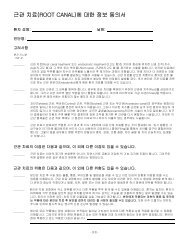GUIDELINES TRADITIONAL CHINESE INFORMED CONSENT
guidelines for traditional chinese informed consent - The Dentists ...
guidelines for traditional chinese informed consent - The Dentists ...
- No tags were found...
You also want an ePaper? Increase the reach of your titles
YUMPU automatically turns print PDFs into web optimized ePapers that Google loves.
<strong>GUIDELINES</strong> FOR <strong>TRADITIONAL</strong> <strong>CHINESE</strong><br />
<strong>INFORMED</strong> <strong>CONSENT</strong><br />
TDIC designed these forms to facilitate your “Informed Consent” discussions with your Traditional Chinesespeaking<br />
patients. While the forms are excellent educational tools and assist patients with making an informed<br />
decision, if you do not speak and understand Traditional Chinese a person who can translate the patients’ questions<br />
and the dentist’s answers is required to fulfill the informed consent duty<br />
History of informed consent<br />
The modern doctrine of informed consent is based on the assumption that the patient must bear the expense,<br />
pain and suffering of any injury resulting from medical treatment and, therefore, has the right to know all<br />
material facts about the proposed treatment.<br />
The American doctrine of informed consent grew out of the concept of battery, which is defined as unpermitted<br />
physical contact. Early in this century several court cases established the duty of health care providers to obtain<br />
the patient’s consent prior to treatment. Consent became informed consent in the 1950s and ’60s when several<br />
courts specified the types of information that health care practitioners must disclose to patients in the course of<br />
obtaining informed consent.<br />
In Illinois, as in most states, the dentist has an affirmative duty to disclose the risks, benefits and alternatives of<br />
treatment. A failure to obtain informed consent is professional negligence, whereas failure to obtain consent is a<br />
question of battery.<br />
A definitive statement as to how much a doctor should disclose to his patients is found in Miceikis v Field<br />
(1976), 37 Ill.App.3d 763, 768, 347 N.E.2d 320, 324:<br />
A doctor has a special relationship with his patient. [Citation.] This relationship not only vests the doctor with the<br />
responsibility of disclosure, but also requires the doctor to exercise discretion in prudently disclosing information in<br />
accordance with his patient’s best interests. To disclose more than that which is material would run counter to the<br />
responsibility assumed through the doctor-patient relationship.<br />
455 North Eastern Reporter, 2d Series<br />
The duty to disclose<br />
Although informed consent specifically involves the education of the patient, it also represents the culmination<br />
of the process of developing a diagnosis and treatment plan. Only by having a solid diagnosis and realistic plan<br />
for treatment can the dentist reliably inform the patient about the nature of the proposed treatment, the benefits<br />
and alternatives, risks and potential consequences of not performing treatment. The process of informing the<br />
patient can be seen as a model for the dentist-patient relationship, one in which the dentist shares his or her<br />
knowledge, findings and recommendations as part of a cooperative effort to help the patient achieve a healthy<br />
oral condition.<br />
The dentist should assist the patient in making an informed decision about proceeding with the proposed<br />
treatment or procedure by explaining:<br />
• if the dentist is HIV+, this must be disclosed [IL Sexually Transmissible Disease Act]<br />
• the nature of the proposed treatment or procedure, including the cost and expected time for<br />
recuperation or healing.<br />
• the benefits of the proposed treatment or procedure.<br />
• the most common and severe risks associated with the proposed treatment or procedure, including the<br />
effect of the individual patient’s specific condition or needs as well as the possible need for further<br />
treatment, including the possibility of death if applicable, i.e., reaction to anesthesia.<br />
• any reasonable alternatives to the proposed treatment or procedure, including the benefits and risks of<br />
each, and the risks and consequences of doing nothing.<br />
Page 1 of 3
Informed refusal<br />
If the patient refuses the proposed treatment or procedure, the dentist must inform the patient about the likely<br />
consequences and obtain the patient’s informed refusal.<br />
Merely obtaining a patient’s informed refusal does not relieve the dentist from practicing within the standard of<br />
care. Even if the dentist fully discloses the potential consequences of refusal and the discussion has been<br />
documented properly, a patient may not consent to substandard care nor may the dentist ethically or legally<br />
agree to provide it. Particularly in the case of refused x-rays, the patient’s decision may effectively prevent the<br />
dentist from providing further treatment. This fact should be addressed during the informed refusal discussion.<br />
Exceptions to disclosure<br />
The dentist has no duty to disclose where:<br />
• the patient asks not to be advised.<br />
• the procedure is simple and any danger is remote and commonly understood to be remote. For<br />
example, the risk of death by anaphylactic reaction following an injection is a remote risk of treatment.<br />
• the risk is minor and seldom results in serious side effects. For example, gingival discomfort while<br />
biting down on bitewing x-ray films is a minor risk of treatment.<br />
• disclosure would so seriously upset the patient that he or she would be unable to rationally weigh the<br />
risks of refusing the procedure (known as the therapeutic exception).<br />
In addition to these exceptions, informed consent is not required in very rare instances where the need to<br />
respond immediately to an unanticipated condition or a life-threatening emergency makes it impossible to<br />
obtain the patient's informed consent. However, since dental emergencies, unlike medical emergencies, are<br />
rarely life-threatening, the dentist should make every reasonable effort to obtain the patient's informed<br />
consent or refusal.<br />
The informed consent discussion<br />
The dentist should obtain the patient’s informed consent through a face-to-face discussion that allows the<br />
patient sufficient time to make an informed decision. If the dentist does not speak the same language as the<br />
patient, in this case Traditional Chinese, a person who can translate the patient’s questions and the dentist’s<br />
answers is needed in addition to the written information translated into the patient’s language.<br />
Ideally, the informed consent discussion should take place at least several days before treatment, such as when<br />
the dentist presents the treatment plan (this is particularly important for extensive, complex or risky treatment).<br />
Since the dentist should disclose information in a manner the patient can understand, the discussion should<br />
involve lay terminology, not scientific jargon. For the same reason, consider providing translated informed<br />
consent materials and, if necessary, an interpreter for non-English-speaking patients who may require it. The<br />
dentist must decide what to tell the patient about a procedure based on whether the patient has undergone the<br />
same or similar procedure previously. The use of educational materials is recommended.<br />
Because the dentist bears the ultimate legal and ethical responsibility for informing the patient, the informed<br />
consent discussion cannot be delegated to staff. Although staff can assist by presenting the patient with printed<br />
or audiovisual materials, the dentist should personally solicit and address the patient’s questions and concerns.<br />
Informed consent for minor patients<br />
For minor patients, obtain the informed consent of the parent, custodial parent or legal guardian. Where parents<br />
live separately, the patient’s personal information form should indicate which parent is the custodial parent.<br />
Where separated parents share custody, the patient’s record should contain letters from each providing consent<br />
and authorization to treat. Asking for a parent’s or custodial parent’s blanket consent for emergency treatment in<br />
advance of an emergency is one useful way to avoid confusion and delays should the patient require emergency<br />
care when a parent or legal guardian is not present.<br />
Page 2 of 3
Documenting informed consent<br />
The patient’s treatment record should reflect: 1) that the patient read the form in Traditional Chinese and<br />
had all questions answered in Traditional Chinese, 2) who translated the questions and answers during the<br />
discussion, and 3) whether the patient consented or refused treatment as proposed.<br />
Nothing in Illinois law specifies a means for documenting the informed consent discussion. At minimum, the<br />
patient record should document the fact that the patient received information about risks, benefits and<br />
alternatives and consented to or refused the proposed treatment or procedure.<br />
Where the proposed treatment or procedure is extensive, invasive or risky, a written informed consent form is<br />
recommended for facilitating and documenting the discussion.<br />
Content of informed consent forms<br />
Forms for many procedures are available through professional liability insurers, commercial vendors and dental<br />
specialty organizations. Many dentists customize purchased forms or develop their own forms. In either case,<br />
adequate forms should address the nature of the proposed treatment, benefits and alternatives, risks and the<br />
potential consequences of not performing treatment, as well as enable the dentist to include information specific<br />
to the case at hand. The form should be signed by the patient, the dentist and a witness. The patient should<br />
receive a copy of the form and the original should be kept in the patient’s chart.<br />
Summary<br />
• Obtaining informed consent involves providing the patient with information about the nature of the<br />
proposed treatment, the benefits and alternatives of the proposed treatment, the risks of treatment, as well as<br />
any other information specific to the patient’s unique condition. Patients who refuse treatment must be<br />
informed of the potential consequences of their decision.<br />
• Informed consent is a process, not a form. It involves a face-to-face discussion between the dentist and<br />
patient, thus a translator is needed if the dentist and the patient do not speak the same language. The<br />
discussion should be conducted with sufficient time to address all of the patient’s questions and concerns.<br />
The task of obtaining a patient’s informed consent cannot be delegated to staff.<br />
• The informed consent discussion should be documented in the patient record, although the law does not<br />
specify the means by which this is done. It should indicate: 1) that the patient read the informed consent<br />
form in Traditional Chinese and had all questions answered in Traditional Chinese, 2) who translated the<br />
questions and answers during the discussion, and 3) whether the patient consented or refused treatment as<br />
proposed.<br />
• The informed consent discussion, even if properly conducted and documented, does not absolutely insulate<br />
the dentist from an allegation of negligence or lack of informed consent. However, being able to supply<br />
documentation of the discussion often dissuades patients from pursuing a complaint. In all cases, thorough<br />
documentation greatly increases the dentist’s chance of successfully defending against such allegations.<br />
For more information<br />
For more information about informed consent call 800.733.0634 or fax your request to 916.498-6175.<br />
Page 3 of 3<br />
Traditional Chinese - IL



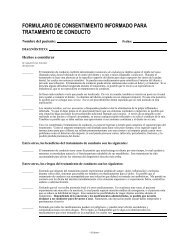
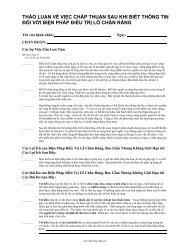
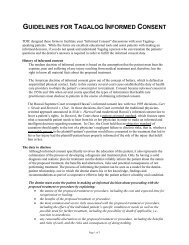



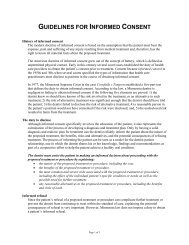

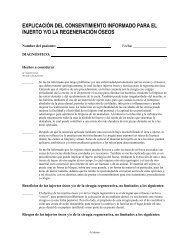

![치아 미백(표백)[TOOTH WHITENING (BLEACHING)]에 대한 정보 동의서](https://img.yumpu.com/52851055/1/190x245/-tooth-whitening-bleaching-.jpg?quality=85)


